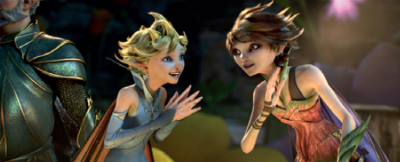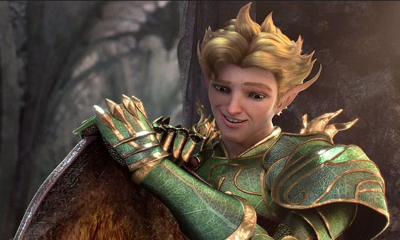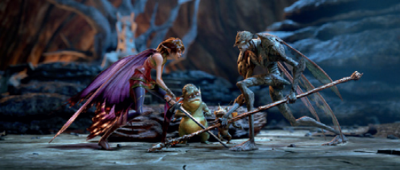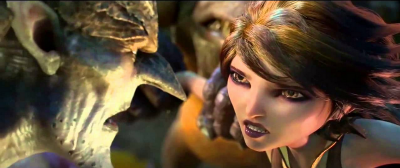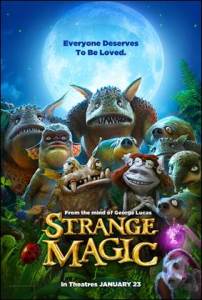STRANGE MUSIC is music to my heart! Think an animated “Moulin Rouge!” that embraces the George Lucas ideals of dark & light, finding beauty and love in the darkest places, experiencing incredible new worlds, and all set in another kind of galaxy far, far away, this one comprised of The Fairy Kingdom and The Dark Forest. Marianne is a fairy princess sworn off love while her sister Dawn is as giggly as a teenager with every male creature she meets. Roland is a less than charming Prince who only has eyes for the throne of The Fairy Kingdom and determines to take it no matter who or what he uses to get there. Sunny is an easy-going happy little gnome deeply in love with his best friend Dawn. And then there’s The Dark Forest. Presided over by the Bog King, love is a word never to be uttered and its inhabitants live in fear of his wrath. Imprisoned by the Bog King is Sugar Plum Fairy who has a penchant for making love potions. Joining in the fun within both kingdoms is a bevy of adorable little pixies, fairies, sprites, birds, bugs, woodland creatures and one mischievous little Imp. Always separate worlds merely divided by a path of primrose, what happens when love and deceit rear their ugly heads and the worlds collide is the stuff of which dreams, and fairy tales, are made.
While infused with Shakespearean notes harkening to “A Midsummer Night’s Dream”, noteworthy is that the core ethos, messaging and story design of STRANGE MAGIC, is easily analogized and paralleled to the constructs of the “Star Wars” franchise; Luke Skywalker walking into the cantina with Obi Wan, or saw the strength in Marianne that mirrors that of Princess Leia, or the dark side of Darth Vader as here seen in the Bog King. There is no doubt that the origins of STRANGE MAGIC lie within George Lucas.
Music is key and calling on songs spanning the past 60 years, Marius De Vries, the same music supervisor Baz Luhrmann looked to for “Moulin Rouge!”, STRANGE MAGIC director Gary Rydstrom now turns to and as a result, achieves the same joyous musical experience. Written by David Berenbaum, Irene Mecchi and Rydstrom from a story by George Lucas, story and animation bloom from the music and the songs.
Technically, the animation is glorious, particularly the use of color. And when it comes to cinematography and lighting for creating mood and texture, as well as providing its own layers of storytelling, the work is meticulously designed and executed, in many cases harkening back to the styling of Old Hollywood and the days of film noir.
While outwardly surprising, the voice casting and its diversity hits all the right notes both in musicality and character personality. Key is that all the singing is done by the actors cast, among them, Alan Cumming, Evan Rachel Wood, Kristin Chenoweth, Alfred Molina, Maya Rudolph, Elijah Kelley, Sam Palladio and Peter Stormare.
Although not for everyone, STRANGE MAGIC is, again, very much akin to an animated “Moulin Rouge!” with its construct. It’s fun. It’s whimsical. It screams George Lucas with the subtext, symbolism and messaging. It’s a joyous movie-going experience. Sometimes you just need flights of fancy to remind us of the hidden joy and beauty of the world of wonder.
I had a chance to speak exclusively about STRANGE MAGIC with Gary Rydstrom, who is currently in Singapore, and understandably excited about the release of STRANGE MAGIC this weekend. Rydstrom, seven time Academy Award winner for Best Sound and/or Best Sound Effects Editing, while having previously directed the English dub of “The Secret of Arrietty”, had yet to actually direct a film from inception to fruition, now marks STRANGE MAGIC as not only his first feature direction, but first ANIMATED feature direction, and a MUSICAL at that. Excited, enthusiastic, candid and sounding as gleeful as a kid on Christmas morning, Rydstrom talked with me about STRANGE MAGIC which presented lots of new experiences and challenges on a myriad of fronts, starting with the music.

When it comes to the musical construct and working with Marius De Vries, there is a cohesiveness with the song selections and their appropriateness for emotion and character which is then mirrored by the visual animation and tonal bandwidth.
The musical part was new to me and I was a little scared going into. It was scary enough to direct an animated film but I’m competent at it. But with a musical? I don’t know a thing about a musical. It was fun to learn and Marius has a great sense of musical structure. I especially loved how to figure out how to get in and out of songs and structure it so they don’t slam in and surprise you in a way that sometimes you can do in musicals. “Whoa! We’re singing!!” That was a fun thing to try to figure out how to weave the singing of the dialogue from head to tail.
What was that learning curve for you? You have a very seamless flow and you have always have a haunting undercurrent of a song leading up to a full on song.
And that undercurrent is key. There’s an especially sneaky one before we hit the song “Strange Magic”, that comes out of score. The score starts to have that “da da da da dum”, the little falling notes of “Strange Magic”, but I love doing that because it helps gently lead you in the song. Marius is doing that in score throughout, anticipating something or reminding us of a song that we heard earlier and using it in score. My learning curve was, first, leaning on Marius as the music supervisor in picking the songs and arranging the songs and then editing the songs into the reels. . .I was using myself as a guinea pig. If I didn’t go, “Whoa! This is making me laugh in a bad way to start the singing here” or it feels wrong, [it was okay]. So I was using myself as the audience guinea pig. But I leaned on Marius. And Irene Mecchi was one of our writers. She did “The Lion King” and she knows musical structure. I tell them half-jokingly that from now on any movie I make has to be a musical because it’s just too much fun!
Speaking of the music, the number of songs, the titles of songs, how was there any money leftover to do anything else after you got through the licensing fees. The licensing fees for the songs in STRANGE MAGIC are not cheap.
Steve Gizicki, that’s his job to negotiate with all the people about these songs. Everyone he talked to were happy to help. It’s certainly a big part of a fairly big music budget, I’m sure, but it’s also kind of the backbone of the movie. There is no other way to do it. Going back to George Lucas’ initial idea, he wanted to tell a love story-fairy tale through songs. That’s what we did. I don’t remember ever throwing out a song or changing a song on the basis of money. I know there are sometimes I’m probably not getting my money’s worth; for example, there’s a snippet of “People Are Strange”, The Doors song, with the mushroom shot. . .And then we have “Barracuda” in there in the score and in some ways it anticipates the Heart song straight on as it’s such a central cong later in the movie. Something about using “Barracuda” as score with that distinctive guitar rift is good. And that’s a lot of what Marius brought to it, and that is, connecting things. The most obvious thing is using songs like “Can’t Help Falling In Love” in different ways throughout the movie. And “Three Little Birds”. . .[T]he original concept for this, too, was certainly to have songs that kids and people will recognize but also have great songs that you might not know that kids and others get introduced to. [laughing] The challenge is, you have pretty much every song ever written to choose from, so what do you choose.
So, what came first? The animation or the music?
The music. Every scene that we would go into with animation, if it was a musical scene, we had to have the music locked down. Music, just like the dialogue, came first. Before we’d go into animation we had storyboard reels with the music. Marius was always good at mocking up, even before we might have recorded the actors to get the song in good shape so we knew what we were going through. You can imagine the timing is pretty tight. Once we go into animation we’re locked for timing pretty much. Music came first.
The visuals are a beautiful blend of styles and types of animation. You’ve got a lot of photorealism with both forests which just leap off the page almost with a three-dimensional element to them. Then you add the whimsy and fantasy through the creatures themselves and how they’re created. But they are two very distinct looks, yet they marry beautifully. Much like the fairy forest and the dark forest. You’ve got that typical George Lucas, black & white, good & evil, going on.
That’s true. The look of it is something I’m really proud of. . .A lot of the work was done at Lucasfilm Singapore. They did the lighting and animation to a degree. . . they did amazing work. In my mind, we’re a studio that doesn’t just do animation. It has this live action DNA to it. The richness and the detail and the grittiness of it comes from a live action sensibility and then we do animation within it which is really nice to do. If you think that the theme of the movie is to find beauty in unexpected places, in things that might seem strange or ugly on the outside, you need that level of detail and grittiness and organic natural feel to it. The world is full of great little details but so are the characters. The characters fit their worlds and they’re full of great little details in their clothing and their faces and the hair. They are wonderfully detailed.
I’m looking at Roland and the animation and detail is so beautiful in his green armor, it looks like a piece of cloisonne jewelry with the enameled finish on it. Absolutely stunning!
I told the lighter to light him like you were a studio photographer in 1940 for Barbara Stanwyck. So the film is lit in this classic Hollywood back-lit, rim, gauzy look that helps them look even more perfect.
What is also beautiful is the color palette itself. You stretched the typical color palette. I saw Bob Stromberg do that with “Maleficent”. I saw James Gunn start doing that with “Guardians of the Galaxy”. Getting more into the purple-fuchsia blending and some of the jewel tone pop art colors of the Peter Max era. It’s not something we’re used to seeing in animation.
Again, I think the color palette follows the same idea. There’s a richness and a depth to it that is not so simple as you might have us do in a more stylized animated film. That purple color you talked about is really key to Marianne’s wings which are based on butterfly wings, the colors that those have. We used a lot of this lavender pink colors, just beautiful rich, almost royal colors. She is a princess after all and they feel very royal. But like you said, this is a George Lucas story of two different worlds – of dark and light – so we got to do real fun contrast in the color palette of the Fairy Kingdom and the color palette of the Dark Forest where we sucked [the color] out. There were no happy greens in the Dark Forest. It was almost a blue haze over it, a cool, very very cool tone. The Fairy Kingdom was very very warm. We put varied characters, like Marianne, into the Dark Forest which is nice so now we have those warm colors from the fairy world invading the cool desaturated colors of the Dark Forest. I love contrast. I love contrast in all things. So we built on the contrast.
The cinematography and the lighting, as the fairies start infusing the Dark Forest and you start to see the backlight start to come up and the inkier, suedey blue kind of disappear and lighten up, is so beautiful. It appears a gradual progression.
It is. And it takes place at night. One of the challenges we had was how many different ways can you light a full moon evening depending on the mood of it. I have to say, I enjoy lighting a daytime happy forest, but lighting a dark forest at night is a lot of fun.
So, how many different ways are there to light a dark forest at night, Gary?
[laughing] There are approximately six! It turns night and there are some moments – there’s a shot or a scene where the Imp is being chased by Sunny and that’s the Fairy Kingdom at night, so it has a little more saturated colors. We see some blue, happy blue, in the sky even though it’s nighttime. The skin tone on the characters is still warm, as much as we can get away with. You still see the colors of the flowers around it. More of a high key look. And then the Dark Forest is a lot of uplighting, sort of bouncing light off of a creek below us. I’ve always talked about “Boris Karloff shots” so we would have the light for some reason, probably unexplained, come from below. But it depends on the mood of the scene in the dark forest. When we get to the “Strange Magic” part, now we’re not scary so much anymore. Now we’re dealing with making the nighttime really beautiful in that same Dark Forest. Now we do these firefly glowing warm colors and things like that to make it rich. Same place that you saw earlier that was scary but now it’s supposed to be incredibly beautiful.
You mentioned the fireflies and that leads me into the ever present movement. It’s rare that we see Marianne ever stop moving, or, other than when sitting on his throne, the Bog King. Wings are always moving, wings are always fluttering. The little feet are even fluttering in the air. How challenging is that when you’re animating to create that and then to create a believable flutter and motion?
It was a big challenge. The animators did a lot of studies of how butterflies and other creatures flew. To look at them in reality, they’re very stiff, the wings are very stiff. We ended up loosening our fairy wings to have the softer look to it. But we wanted it to be believable, we wanted you to believe that they were flying. Part of the coolness of a character like Marianne is that she can fly, and that’s amazing! The very first shot of her in the movie is the long shot of her flying through her world. The wings became part of the animation – when does she flap them, when does she get nervous and flap them quicker, when does she slow down without losing altitude. There’s a lot of times where she kind of slows down her wing flaps to think about something and you’ll see her lose altitude a little bit and she has to get a little more airborne. [laughing] I thought it was like an animator having a dog tail to animate to. It’s another aspect to the personality to get across and how she is using her wings to tell us what she’s thinking. Plus, it’s just damn beautiful! And the lighting of it! You can backlight them, you can get a little bit of light through the wings. I start to see them like Tiffany windows.
You get this beautiful opalescence translucence. Some of those shots are just breathtaking.
Thank you. It’s important in this movie to have those breaths of classically breathtaking shots on the Fairy Kingdom side and beauty in the way that we’re used to seeing it because the movie really is about them seeing beauty in everything in the Dark Forest and the Bog King himself, which is not classically beautiful, and make that look beautiful. Our biggest challenge was, with Bog King specifically, there were so many scenes where we had to like him more or got to know him more. The poor lighters were talking about how to give him a more romantic light. If you look at that character, he’s so spiky, not a good looking guy, and how do you do that. They figured out ways to do it like an old Hollywood DP getting the ugliest actor in the studio. Like a Humphrey Bogart movie. How do you make him handsome? And they did it.
Bog King, who I have to say is my favorite character and performance in the film, I think Alan Cumming just knocked it out of the park, but very definitely had intonations of a noir lighting to him.
Yes. I’m really happy – some people have said, I really like how you changed and took some of the moles and the scales and the creepy stuff off of him during the course of the movie – of course, we didn’t! We did it strictly with animation and lighting and Alan Cumming’s vocal performance. We have to have you fall in love with that character in a way by the end of the movie despite how he looks.
Even at his darkest, I was so drawn to him because of the layers and level vocal inflections. You knew there was more beneath the surface. It was wonderful to listen to watch the transformation of the Bog King.
I don’t know who else could have done it. Alan Cumming was essential. We needed a really great actor who could sing and be empathetic even when he’s sounding evil. It’s that indescribable thing with actors, especially with their voices. You hear Alan Cumming and you find him intriguing even as he’s scaring you. That’s part of the casting of an animated film – is finding that voice, that actor, that without looking at the real actor, you sense the depth to them just from hearing their voice. [Alan Cumming] is a talented guy, obviously. He can do different things. He puts on this bit of a bad guy voice in the beginning and it doesn’t exactly go away; he’s still the same character at the end, but now he sounds like a gentleman at the end; the softest kindest gentleman you can imagine, but it’s the same voice. You recognize him as the same character who started the movie.
Because this is a musical, unless you’re going to dub in voices for the voices already doing animation, you need to find actors who can sing. What was that search like to find the right voice for each character? These aren’t cookie cutter characters.
Yep. Well, we found ‘em! [laughing] Evan Rachel Wood [voicing “Marianne”]. I’m really proud that we found her. We knew she was a great actress and she’s got a great voice. We were looking for a range for that character to go from naive to tough girl to falling in love. She can do that but we first saw her online. And thank God for the Internet. There are all these videos of Evan singing and she can do anything! She can sing soft ballads all the way through hard rock, so that’s what drew us to her. We needed that character to have a range for singing in a way that no other character in the movie had.
Of course, no surprise was Kristin Chenoweth. I was in the room when she was singing “Love Is Strange” and she had to hit these high notes. She is operatic! She’s amazing to behold and I think my glasses cracked when she was hitting those high notes. She’s so petite, but man, can she sing with gusto! And again, the combination. She’s an amazing singer but she’s really funny and that character [Sugar Plum Fairy] she kind of tore into it in terms of the craziness and fun of that character.
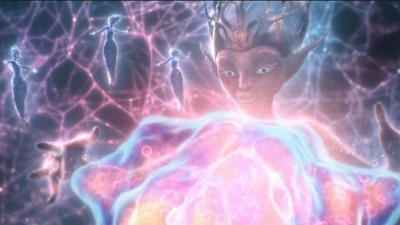
With your expertise in sound, I would be remiss not to talk about sound. The fact that I could hear the crumpling of little primrose petals, the attention to the microscopic sounds of a forest and the flutter of wings, was just beautiful. Meticulous auditory detail.
Oh good! Thanks! The wings are a big part of it to remind us that these are flying characters. . . E.J. Holowicki was our sound designer and finding the right sounds, especially the Bog’s wings which were very different sounding and harsher, and Marianne’s wings which are soft. But you’ll notice we do the same thing with sound we do with lighting. The Bog’s foley, his body sounds, his crackle sounds, his wings, start out really harsh and scary but by the end they’re much much softer. We cheated on the sound side and I actually softened him during the movie in a way that we don’t with his actual model. Sound is such a great subliminal tool. . . The sound mix was one of the hardest things to do, quite honestly, because it’s got a lot of music and a lot of stuff going on. And because I’m ME [seven time Oscar winner for sound], we paid a lot of attention to the sound and how it can help focus the story and tell you where you are and help set the mood.
Now having made it through this beautiful film, what did you learn about yourself as a director that you can take into your next project that you’re going to direct, that you’d better be directing, that I expect to see you directing?
[laughing] Thanks for saying that! What I learned? I’ll tell you – musicals. I learned about things that I loved that I had no experience with. Even animation is new to me. I don’t have an animation background except for what I’ve done at Pixar and what I’ve learned in making animated films and making this movie in particular, is that I love working with animators. I think they’re a breed apart and it’s the same technique as working with the voice actors. You’re talking about story and character and emotional beats and all that stuff. I love doing that. It’s something that I can’t do myself so I love talking through it with people who do amazing work in animation and the voice actors. And when those two things come together, that’s the most fabulous moment for me in the film when the characters start to become alive. I learned how much I love that, the magic of creating a character out of whole cloth, watching them come alive. I learned how much singing and songs have such an emotional pull on us and I am drawn to these songs in a powerful way. I know they can help tell a story but it can tug on our heartstrings in a way that nothing else can. I learned a lot about how much I love the process of making films.




